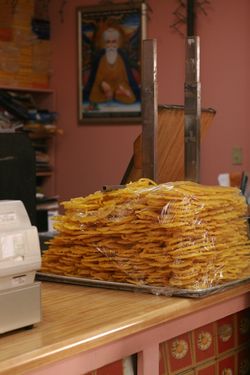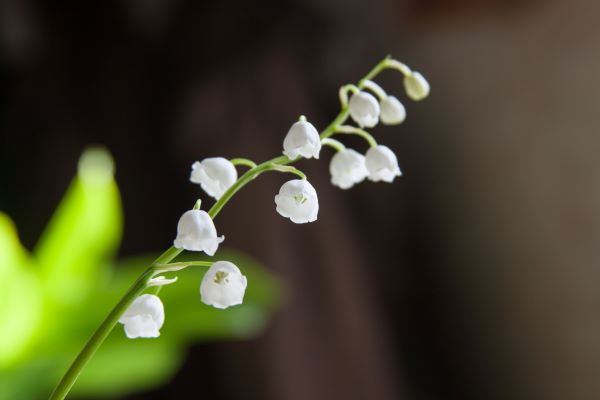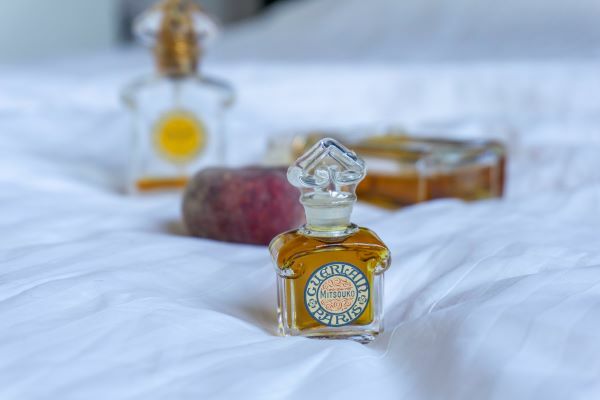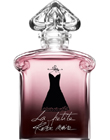Have you ever tasted civet? Civet essence is obtained from the perineal glands of a mongoose-like creature, and it has a penetrating, warm, sweet odor. Pure civet tincture smells fecal and cloying, but diluted, it has a radiant, velvety scent. A discreet touch of civet can give incredible warmth and diffusion to the simplest floral accords. Natural civet has been slowly phased out, having been replaced by synthetics, yet nothing can truly duplicate the natural essence. If you compare Chanel No 5 made pre-1998 (when natural civet was replaced by its man-made analogue) with the perfume available today, the difference is clear. There is an ineffable richness and opulence that makes the rose and jasmine accord of No 5 seem shimmering.
After this introduction, my original question might seem strange. The use of civet and other animalic essences in fragrance is fairly well-known and can be traced to ancient times. However, equally traditional is the use of animalic essences in food. In The Accomplisht Cook, a cookbook dating to 1685, Robert May published a wide range of recipes for various preparations in the baroque style of his time. Among the sweetmeats, there were several recipes calling for musk, civet and ambergris (see two recipes below.) Although in the 17th century, the use of spices was considerably more refined than that of earlier periods, fragrant flourishes were present in nearly every dish. The floral and animalic essences that most of us today associate with cosmetics and perfumes were widely used in both sweet and savory preparations. Even then, these materials were rare and expensive, available only to wealthy kitchens. Their usage was exotic and original, paralleling the love for civet scented gloves and pomades in European society of the time.
While May’s recipes might strike us today as strange, if you lived through the 40s and 50s, you might have tasted natural civet in various commercial raspberry flavored preparations. It used to be an essential material for constructing the rich, realistic berry flavor. Musk, another animalic essence derived from musk deer, has also been used to create fruit flavors, particularly strawberry and melon, while today the synthetic versions are more likely to be used. Musk flavored Lifesavers and other candy can be found in Australia and New Zealand, and they taste pleasantly floral. Ambergris, a substance obtained from sperm whales, has a salty-sweet fragrance and is used in Egypt to flavor cigarettes, while in Morocco some traditional meat preparations include it in combinations with oud.
Robert May’s White Ambergriese Cakes:
“Take the purest refined sugar that can be got, beat it and searse it; then have six new laid eggs, and beat them into a froth, take the froth as it riseth, and drop it into the sugar by little and little, grinding it still round in a marble mortar and pestle, till it be throughly moistened, and wrought thin enough to drop on plates; then put in some ambergriese, a little civet, and some anniseeds well picked, then take your pie plates, wipe them, butter them, and drop the stuff on them with a spoon in form of round cakes, put them into a very mild oven and when you see them be hard and rise a little, take them out and keep them for use.”
Muskedines [Musk Candy]
“Take half a pound of refined sugar, being beaten and searsed, put into it two grains of musk, a grain of civet, two grains of ambergriese, and a thimble full of white orris powder, beat all these with gum-dragon steeped in rose-water; then roul it as thin as you can, and cut it into little lozenges with your iging-iron, and stow them in some warm oven or stove, then box them and keep them all the year” (p 202-203, in Filiquarian Publishing LLC facsimile edition.)
The Accomplisht Cook is available as a reprint from amazon.com.
Photograph: Jabeli, fragrant Indian funnel cakes © Bois de Jasmin. Although today jalebi is usually scented with rosewater and saffron, in the Mughal period (16th-18th centuries,) similar fried cakes were accented with musk and ambergris.

















39 Comments
Nikki: very interesting article…I had no idea that these substances were used for cooking as well. It probably was quite delicious and smelled divine. In one of the last Hannibal Lecter movies, the one where he escapes to Florence and meets an Italian detective played Giancarlo Giannini, his downfall is precisely that he uses a handcream with ambergris. The ambergris is detected by “noses” at the FBI who state that this handcream can only have been sold in Italy or Japan due to the endangered species act in the USA. Did I want to smell this handcream, of course I did. However, in view of the pain inflicted on these cat like animals, civet, to increase the excretion of this substance (I saw a film once how they are beaten and tortured in North Africa on “farms”) and the fact that there are few little musk deer are left as they are killed by poachers for the musk sacks, I have to agree with the endangered species act and be a “Mensch”. It is not necessary and certainly not a good thing wearing something when one knows that another living being had to suffer terribly for it. I would rather be less fragrant than cruel and inhumane. Enlightenment in all things means to make conscious decisions based on humane values: so, no to natural civet and musk and ambergris. September 16, 2011 at 9:49am
Carla: Thank you so much. This was fascinating and your comment interested me as well. Things are rarely black and white. September 16, 2011 at 11:00am
Victoria: I do not want to divert the discussion into animal rights under this post (it is a whole other topic!) I am deeply ambivalent on this issue, mostly because civet farming supported certain groups in Africa that have traditionally done this trade. Now that natural civet is being phased out, these people are left with no means to support their families. The poverty and suffering they face are unbelievable as there are few other resources available to them.
As for musk deer, on that I have to agree. It is quickly disappearing. The culprit here is not the perfume industry, but rather the traditional Eastern medicine that calls for musk deer pouches (they supposedly increase virility and have a host of other properties.) September 16, 2011 at 10:31am
50_Roses: Is it not possible at all to buy real ambergris in the US? I agree that killing whales to obtain it is wrong, but surely it can be obtained by other means, as it is my understanding that the whales occasionally regurgitate it, after which it can be found floating on the ocean or washed up on the shore. I would think that ambergris obtained in this manner would be free from any animal rights concerns. September 16, 2011 at 2:45pm
Andy: Fascinating post and I admit that, though I really do wish to someday learn the smell of real ambergris, civet, and musk, we do have to consider the effects of our human pleasures on animals, and how prioritizing the well-being of animals can go to affect humans negatively. I don’t wish to incite a discussion on animal cruelty, however fascinating it may be. Actually, what amazes me is how the perfume houses have been able to replicate thousands of scents using headspace technology, yet are unable to produce a nature-identical musk. I suppose cost may play a role, since some synthetics can be very costly to produce. Natural musk seems to be described as lending a sort of magical refining touch to perfume—I suppose if the musk in nature can’t be completely replicated, the synthetic replacements don’t quite lend that same special touch. September 16, 2011 at 3:02pm
Victoria: Indeed, they are rarely black and white!
The interesting thing is how frequently the animalic essences, natural or sythetic, are used in flavors. Of course, whenever you think of a ripe fruit, especially tropical, it makes sense. It has such a rich musky, animalic facet! September 16, 2011 at 12:53pm
Andy: Such a shame, as I am particularly drawn to fatty, waxy fragrances. To me, it seems a shame that the vintage fragrance style has gone away. I’m so tired of sparkling, squeaky clean fragrances! September 16, 2011 at 5:20pm
Victoria: You are right. True ambergris has to be from regurgitated matter, because the substance in itself does not have the valued aromatic qualities until it ages floating in salted water. Ambergris is still available commercially and the certified vendors have to prove that it was humanely harvested. It is just rare and very expensive. September 16, 2011 at 2:52pm
Victoria: I don’t use natural animalic essences either, but smelling them makes it very clear why they have fascinated people since ancient times. Any natural is very hard to replicate, but animalic essences have their own peculiarities. You are right, some synthetic musks are notoriously expensive to synthesize. The fragrance labs are always in search of a great new musk.
On the other hand, I do not really see modern perfumery using these traditional ingredients, because the fragrance style has evolved so much. People today tend to favor sheer, bright, sparkling blends, whereas the older great fragrances have an unctuous, “fatty” quality. It is just that the fashion is now different. September 16, 2011 at 3:13pm
Lavanya: Fascinating article, V..I don’t want to get into the animal rights aspect, either..Just wanted to say that I love the wording on the recipes, especially of the Ambegris cakes – it is like a bit of frozen time. Thank you for these nuggets of info you provide! September 16, 2011 at 3:18pm
Victoria: I love this book! He also had a few recipes for colorful tarts–white (cream, egg whites, flavored with musk), yellow (more like the usual flan, but with saffron,) red (red berries,) green (sorrel, green plums, etc.) and black (dried plums, quince, apple, spices.) I tried the black tart so far, and it is very delicious.
The recipe for ambergris cakes would produce something meringues, although since he uses whole eggs rather than just egg whites, I can imagine that they would be soft and fudgy. September 16, 2011 at 3:31pm
behemot: The recipes are so surprising to me! It was fun to read them. I had no slightest idea about use of civet in raspberry dishes and musk in candies! Sounds a bit surreal today.
Very interesting post, Victoria..
Thank you. September 16, 2011 at 10:46pm
SarahY: I have heard before that musk-flavoured confectionary is available in New Zealand but where? I have never seen any but would love to try it. September 17, 2011 at 3:25am
SarahY: A search online yields many results. I’m sure I have looked in the past? A trip to a sweets store is in order. September 17, 2011 at 3:28am
Nick: Dear Victoria,
A fascinating post. And I like the fact that you never try to “shock” in your descriptions of animilic scents like many a (male) writer. I find that so trite and dull! September 17, 2011 at 10:19am
Paeonia9: Great article! I’ve been using essences in cooking for awhile. They really do take things to a new level. My personal favorites are Ylang Ylang in the frosting for my Coconut Cake and Tonka Bean for the frosting on gingerbread. Also Litsea Cubeba or Petitgrain in whipped heavy cream for topping fruit tarts. They’re a bit limiting as they can’t be cooked… September 17, 2011 at 1:51pm
Lizzie: How interesting- I had no idea that musk was used in cooking! Now that I think about it, though, I suppose it makes sense.
On the subject of animal-based perfume ingredients, I thought I’d share an interesting discovery my mother made this summer. She works in animal rehab, and every summer she takes home dozens of baby raccoons that have lost their mothers and need some TLC. Sometimes, the babies’ ears get really clogged up with earwax (apparently this is a common problem), so she has to groom them herself with a cotton swab.
Interestingly, she discovered that raccoon earwax has an amazing scent to it, an almost gourmand musk. We’ve joked about collecting it next summer and rendering it into a perfume oil for ourselves, but I don’t know if we actually will. 🙂 Anyway, just a funny little anecdote. September 17, 2011 at 3:32pm
Victoria: They are still used today, but there are other synthetic flavors that have more subtle effects. Musk is an important flavor in the food industry. September 17, 2011 at 1:01pm
Victoria: I have not seen them in the US (the candy market here is very conservative!) A friend brought some from Australia for me to try. September 17, 2011 at 1:01pm
Victoria: Musk Lifesavers used to turn up a link that sold them, but I do not see it anymore. September 17, 2011 at 1:02pm
Victoria: Nick, thank you, I am glad that you found it interesting. The application of these unusual materials, natural or synthetic, also seems fascinating to me. Musk Lifesavers were quite nice. I wish I could get them in the US. September 17, 2011 at 1:03pm
behemot: It is so funny and interesting. I am also very impressed with your Mom, taking home baby raccoons to care for them. How great! September 17, 2011 at 5:04pm
behemot: A bit off topic…
I have a sample of Amouage Gold. It is relatively new. Does anyone know if it still contains natural civet, musk and ambergris or they have been replaced by their synthetic equivalents? September 17, 2011 at 5:13pm
behemot: Thanks a lot! My sample smells fantastic though and has a sort of vintage quality… September 17, 2011 at 5:54pm
Victoria: From the Amouage website: “The musk, civet and ambergris used in our fragrances are all entirely synthetic. There are no banned or restricted natural substances used in any Amouage product.” September 17, 2011 at 5:40pm
Victoria: I love tonka bean when combined with cherries. If you use ground tonka beans, you can bake with them. The scent in the house is amazing when my cherry-tonka bean scones are in the oven. September 17, 2011 at 5:41pm
Victoria: What a fascinating and touching story! Thank you so much for sharing.
I read that crocodiles also have a particular, very sweet, musky scent. September 17, 2011 at 5:47pm
behemot: Yes, there is something “noble” and “quality”about Gold. It smells really elegant and sort of old fashioned. If I finally decide to get an aldehydic floral of this kind, it will probably be Amouage. Gold.
Haven’t smelled their newest frag yet. September 17, 2011 at 11:51pm
Victoria: I have smelled it at Aedes recently, and I thought that it was very good. Not a fan of their latest, but Gold never fails to move me.
Sent via BlackBerry from T-Mobile September 17, 2011 at 8:08pm
Nick: Dear Victoria,
On the topic of animals with incredible scent – apparently tigers paws smell amazing! I know, it sounds crazy! Saw it on a documentary.
Oh, and be sure to let me know if you ever want Musk Lifesavers posted to you from OZ! September 18, 2011 at 9:07am
D: I thought ambergris was whale vomit that floats up on the sea shore. While I can understand that it was always a rare substance, the fewer whales makes the ambergris very rare. Why would harvesting it from the sea shore hurt the whales? September 18, 2011 at 4:43pm
Paeonia9: Oh, that does sound fantastic! Off to buy some tonka beans… September 18, 2011 at 5:47pm
Victoria: I liked Jubilation series, but Lyric and Epic left me a bit disappointed. I am with you on Gold–it is one of the best floral aldehydic in the now vanishing grand parfum style. September 18, 2011 at 2:19pm
Victoria: Nick, thank you very much for your kind offer! For now, I have a stash, but if I run out, I will let you know.
I also read that tigers smell very good at certain times. I only had an experience with the scent of lions. When I was little, my mom took me to see the circus, and one of the shows had lions. We were sitting so close to the stage that we could smell them! I remember not liking it one bit and asking my mom loudly if we could leave. 🙂 September 18, 2011 at 2:23pm
Nick: Dear Victoria,
Thank you for sharing your lion memory. You may like the smell more now! I mentioned the tiger thing to a horse lover, and she was adamant in her belief that only a herbivore could smell good. I don’t think she had ready access to lions or tigers! September 19, 2011 at 8:38am
deana: I cook using historical cookbooks like Mays and have now made a few dishes with ambergris. I get it from a wonderful company in NZ and it is found material. It takes many years on the ocean to age ambergris. without the salt, sea and sun it is pretty awful stuff. As it is, its taste is waxen… you smell it when you eat it. Although I have made pastry and sauces, so far my favorite application is sprinkled on warm vintage port. The result is pure magic.
I have just gotten some reportedly ethically sourced musk (deers are raised for it) and love the scent. I look forward to trying it in food in concert with the ambergris as it often was in the 17th century.
My next purchase is the oud… I have always wanted to smell/taste it!
Great article September 19, 2011 at 9:03am
Victoria: D, you are right, harvesting it from the sea shore does not hurt the whales. It is very rare today and extremely expensive. Originally, it was restricted to avoid using the by-products of whaling industry. So, the new certification is in place to ensure that ambergris is the naturally found substance. September 19, 2011 at 9:10am
Victoria: I have not been near tigers or lions in ages, but the smell of horses is very familiar to me (Central Park with its horse drawn carriages is a couple of blocks from my office.) The last time I had to do a jasmine analysis, I could distinctly smell horse sweat in it (jasmine shares the same molecule in common!) September 19, 2011 at 9:11am
Victoria: I loved historical cookbooks, because they never fail to inspire. Some combinations they offer are fascinating. So, it is great to encounter others who do the same thing.
Oud is a delicious addition to meats. If you come across good-quality Mysore sandalwood, try adding some to milk shakes (especially with rose and cardamom) and custards. It really gives an amazing effect. September 19, 2011 at 9:15am